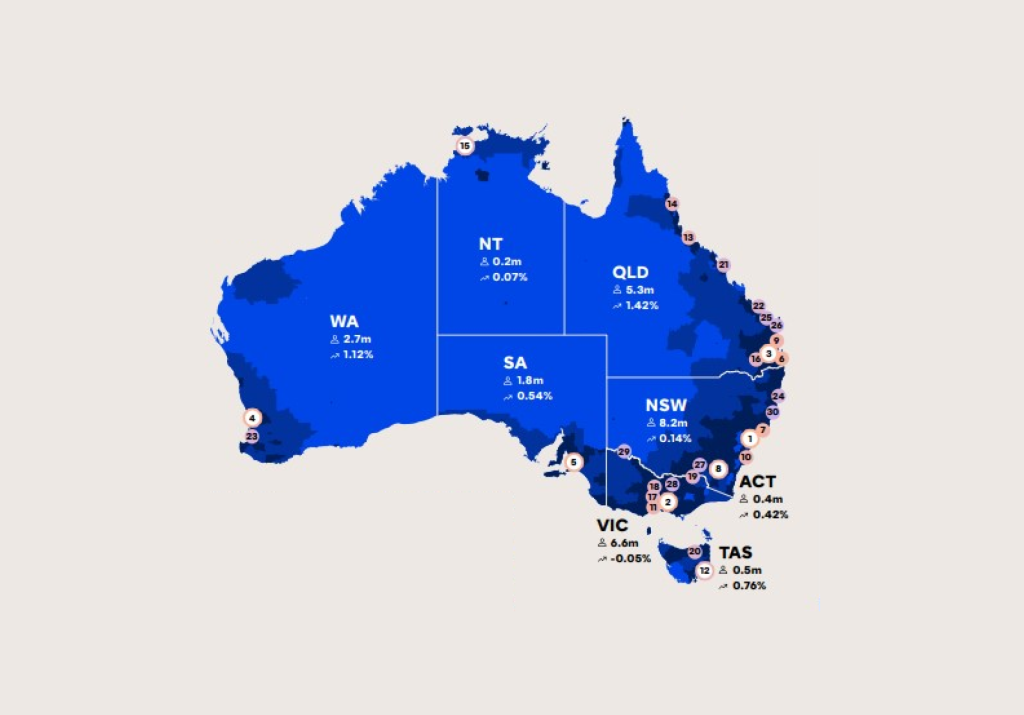By: McCrindle
Tuesday, November 15, 2022 was the day the United Nations estimated the world’s population ticked over the historic 8 billion milestone.
We have added this latest billion, from 7 billion to 8 in the shortest time ever, just 11 years. It took 12 years to move from 6 billion (reached in 1999) to 7 billion (2011). Nor will it ever be equalled again, – amidst slowing growth, it is forecast to take another 15 years to reach 9 billion in 2037.
More than 50% of this last billion has been population growth in Asia, followed by 37% in Africa. They are also the most populous regions in the world at present, accounting for 4.7 billion and 1.4 billion people respectively.
The Population is Getting Older
Since 2010, the global population has aged significantly (median age 27.3 in 2010 to 30.2 in 2022).
A key driver of this is the increase in longevity globally (life expectancy at birth was 70.1 years in 2010 compared to 71.7 currently) along with the declining fertility rates (down from 2.6 children per woman in 2010 to 2.3 currently).
We’ve Welcomed a New Generation
A whole new generation has been born to the world since 2010 – Generation Alpha.
Of the 8 billion people in the world, 1.8 billion have been born since 2010. Generation Alpha (born 2010 to 2024) are already the second largest generation in the world, just behind the 1.9 billion Generation Z (born 1995 to 2009).
In 15 years, the world’s population is projected to reach the 9 billion milestone. When it occurs, Gen Alpha will be the largest generation ever, comprising more than one in five people in the world (22%). By then, aged 13 to 37, the 2 billion Gen Alpha in the world can expect to have an average of 2.22 children (1.67 North America, 1.6 in Europe, 1.77 in Latin America and the Caribbean, 1.85 in Asia, 2.04 in Oceania, and 3.41 in Africa). They can also expect to live to an average age of 75.6 (82.2 in North America, 82 in Europe, 80.9 in Oceania, 78.4 in Latin America and the Caribbean, 77.5 in Asia, and 66.1 in Africa).
How the World Will Look in 2037
The world’s population will also look quite different by 2037. Those born from 2025 to 2039 will be part of Generation Beta. With a population size of 1.7 billion by 2037, these children aged 12 or under will start their lives a world of 9 billion people.
More than 5.1 billion people will live in Asia, followed by 2 billion in Africa. Europe will comprise more than 720 million residents. The population of Latin America and the Caribbean will be similar (720 million). North America will be home to 405 million, and Oceania will make up 52 million.
In fact, over the next 15 years, Europe’s population will decline by 2%, Oceania will increase by 1%, North America by 3%, Latin America and the Caribbean by 6%, Asia by 39% and Africa by 53%.
While this era has been labelled the Asian Century, demographically, we are now in the African Century. Africa currently comprises 22% of the global population, is contributing 38% of current global births, and will contribute 53% of the next billion, to 2037. Currently, Africa’s population is growing by the equivalent of one new Australia (26 million) every eight months. As the global population grows from 8 billion to 9 billion over the next 15 years, Africa will contribute more than half of this growth (53%), and Asia more than one third (39%) with the continents of North America, South America, Europe, Australia and Oceania, together contributing just 8%.”
Global Population Growth is Slowing
Despite these new population records, global growth is now slowing. Current forecasts projects that the world population will reach 10 billion by 2058, 21 years after the 9 billion milestone in 2037.
The world population is also projected peak at 10.4 billion, where it will remain until the end of the century before moving into a period of population contraction.
Throughout the 20th Century, many had fears of overpopulation and ever expanding global demographic growth, however, from a total population perspective, such fears are unfounded. Global annual population growth, now around 1%, is the lowest ever recorded, with some continents now in population decline or fast approaching it. While 8 billion was hit in record time (11 years since reaching 7 billion), it will take 15 years to reach 9 billion, another 20 years to move on to 10 billion, and current models indicate that the world will never reach 11 billion.

Australia’s Population Map
In our population map we bring to you a visualised overview of Australia’s Population and Generational Profile, to help you understand the demographics of this great country.
Article supplied with thanks to McCrindle.
About the Author: McCrindle are a team of researchers and communications specialists who discover insights, and tell the story of Australians – what we do, and who we are.
Feature image: Photo by CHUTTERSNAP on Unsplash
